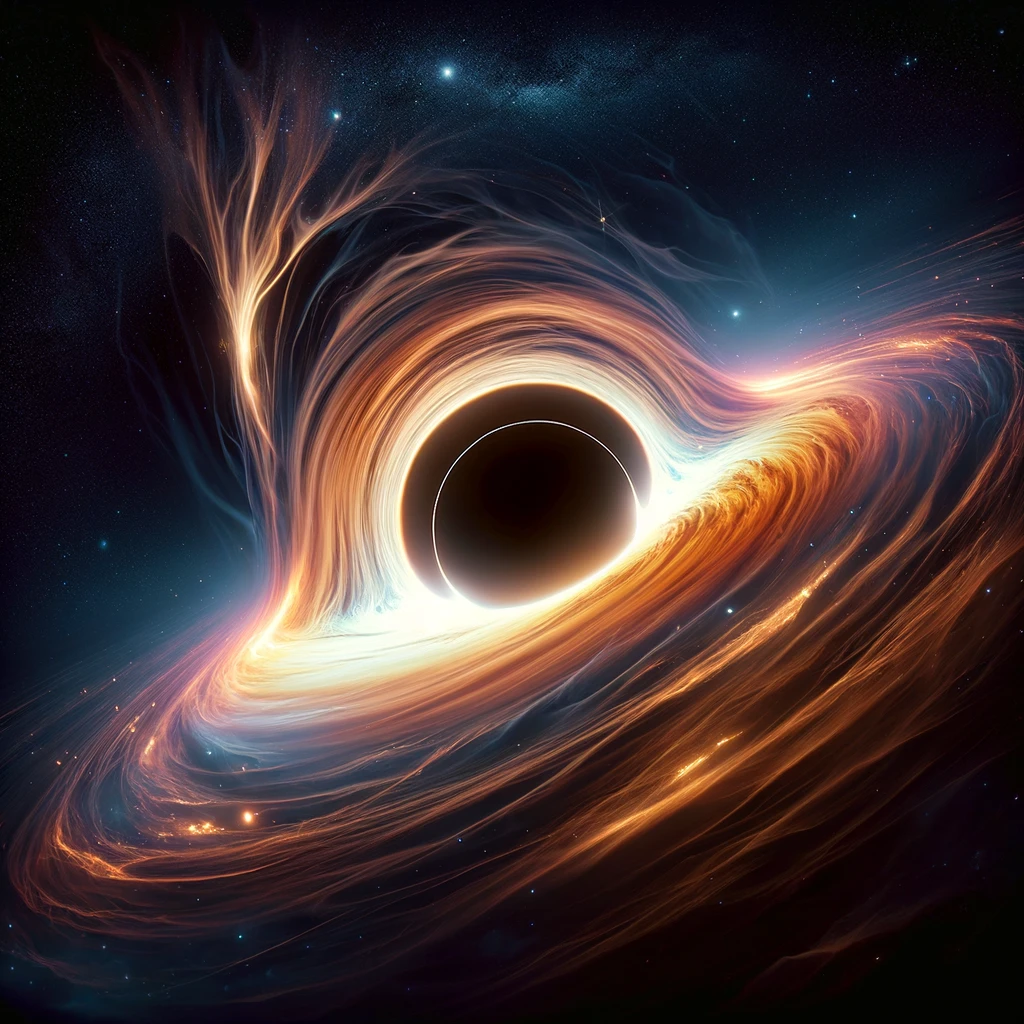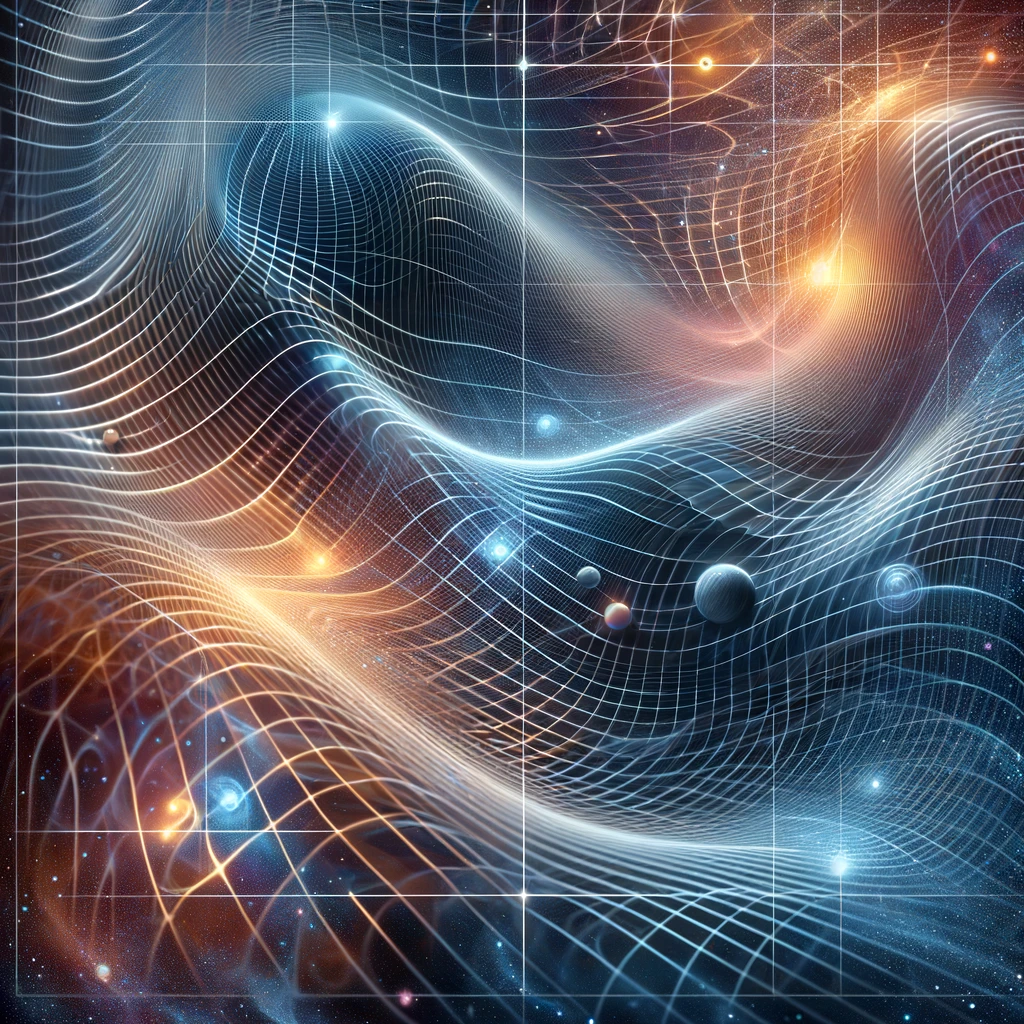
The concept of the fourth dimension can be approached from different perspectives, depending on the context in which it’s used. Here’s a general definition: In mathematics and physics, the fourth dimension refers to a theoretical extension beyond the familiar three dimensions of length, width, and height. While we experience and perceive the world in three spatial dimensions, the concept of the fourth dimension allows us to explore additional dimensions beyond our direct sensory experience. There are four basic categories that can be used to group different approaches of the fourth dimension:
Spatial Dimensions: In geometry and physics, spatial dimensions are used to describe the position and movement of objects in space. The first three dimensions—length, width, and height—define the physical extent of objects in three-dimensional space. The fourth dimension, when considered spatially, is typically conceptualized as a direction orthogonal to the three familiar dimensions.
Time as the Fourth Dimension: In the theory of relativity developed by Albert Einstein, time is considered the fourth dimension alongside the three spatial dimensions. In this framework, known as spacetime, space and time are interconnected, forming a four-dimensional continuum. Objects and events in the universe are described not only by their positions in space but also by their positions in time.
Mathematical Dimensions: In mathematics, dimensions are used to describe the number of independent coordinates needed to specify a point in a space. For example, a point in two-dimensional space requires two coordinates (x, y), while a point in three-dimensional space requires three coordinates (x, y, z). The concept of higher-dimensional spaces, including the fourth dimension and beyond, is used in various mathematical theories, such as vector spaces and differential geometry.
Metaphorical Interpretations: Beyond its mathematical and physical meanings, the fourth dimension is often used metaphorically to describe abstract concepts or realms beyond ordinary experience. For example, in philosophical or spiritual contexts, the fourth dimension may refer to higher states of consciousness, alternate realities, or dimensions of existence beyond the physical world.
In summary, the fourth dimension can be understood in various ways depending on the context, ranging from a mathematical extension beyond three-dimensional space to the interconnectedness of space and time in the theory of relativity, and even metaphorical interpretations beyond conventional understanding.
Einsteins Theory of Spacetime is one concept of the fourth dimension which unifies the spatial concept (from geometry and physics) with the concept of time as the 4th dimension.
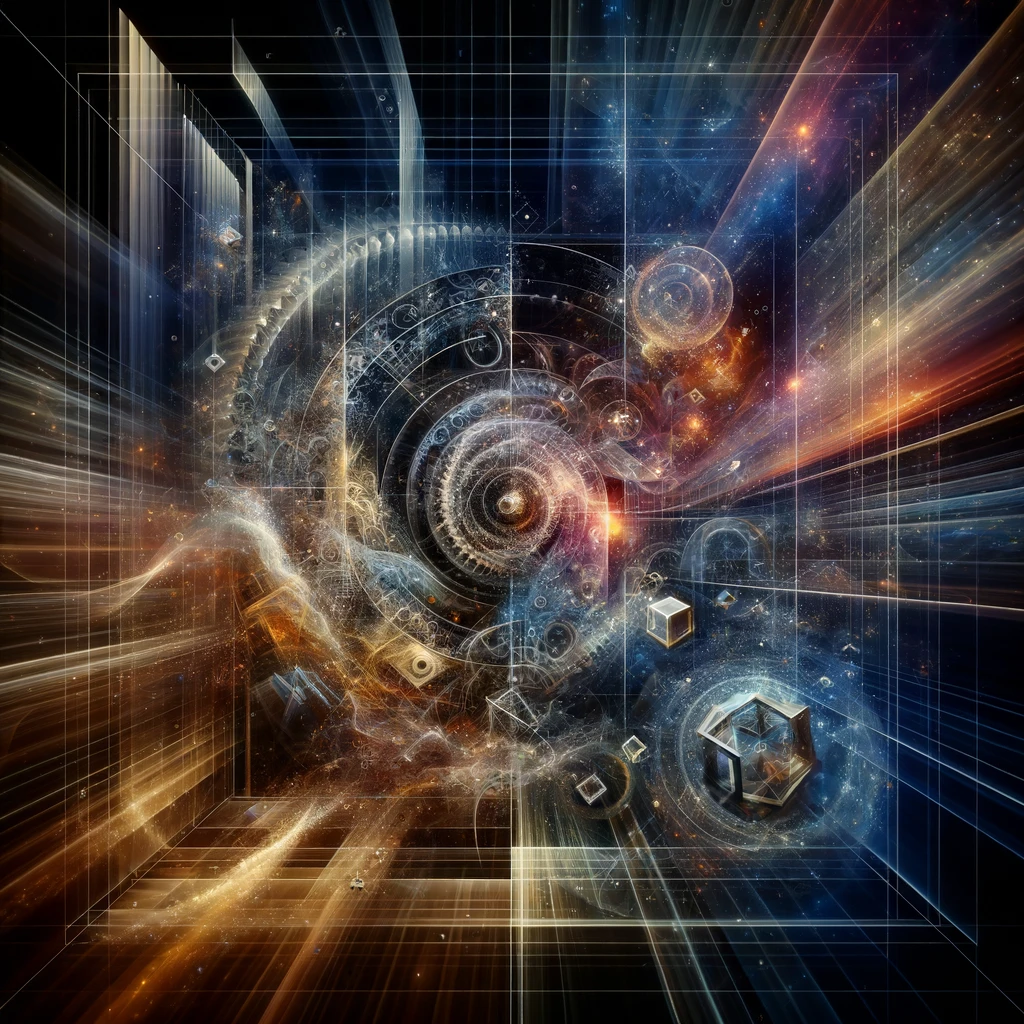
Albert Einstein did not specifically describe the fourth dimension in the context of spatial dimensions, as he primarily focused on the concepts of space and time within his theory of relativity. However, his theories did introduce the idea of spacetime, which incorporates both space and time as a unified four-dimensional continuum.
In Einstein’s theory of special relativity, he proposed that space and time are interconnected and cannot be considered separately. According to special relativity, objects in motion experience time dilation, meaning time passes differently for observers in different reference frames. This concept fundamentally altered our understanding of space and time, treating them as intertwined aspects of a single entity: spacetime.
In Einstein’s later theory of general relativity, he expanded on this idea by proposing that gravity is not simply a force between objects but rather a curvature of spacetime caused by the presence of mass and energy. In this theory, massive objects like planets and stars warp the fabric of spacetime around them, affecting the motion of other objects within that spacetime.
While Einstein’s theories revolutionized our understanding of space, time, and gravity, he did not describe the fourth dimension in the conventional sense of an additional spatial dimension beyond the three dimensions of length, width, and height. Instead, his work reshaped our conceptualization of spacetime, treating it as a unified four-dimensional continuum where space and time are inseparable.
Relativity vs. Spacetime
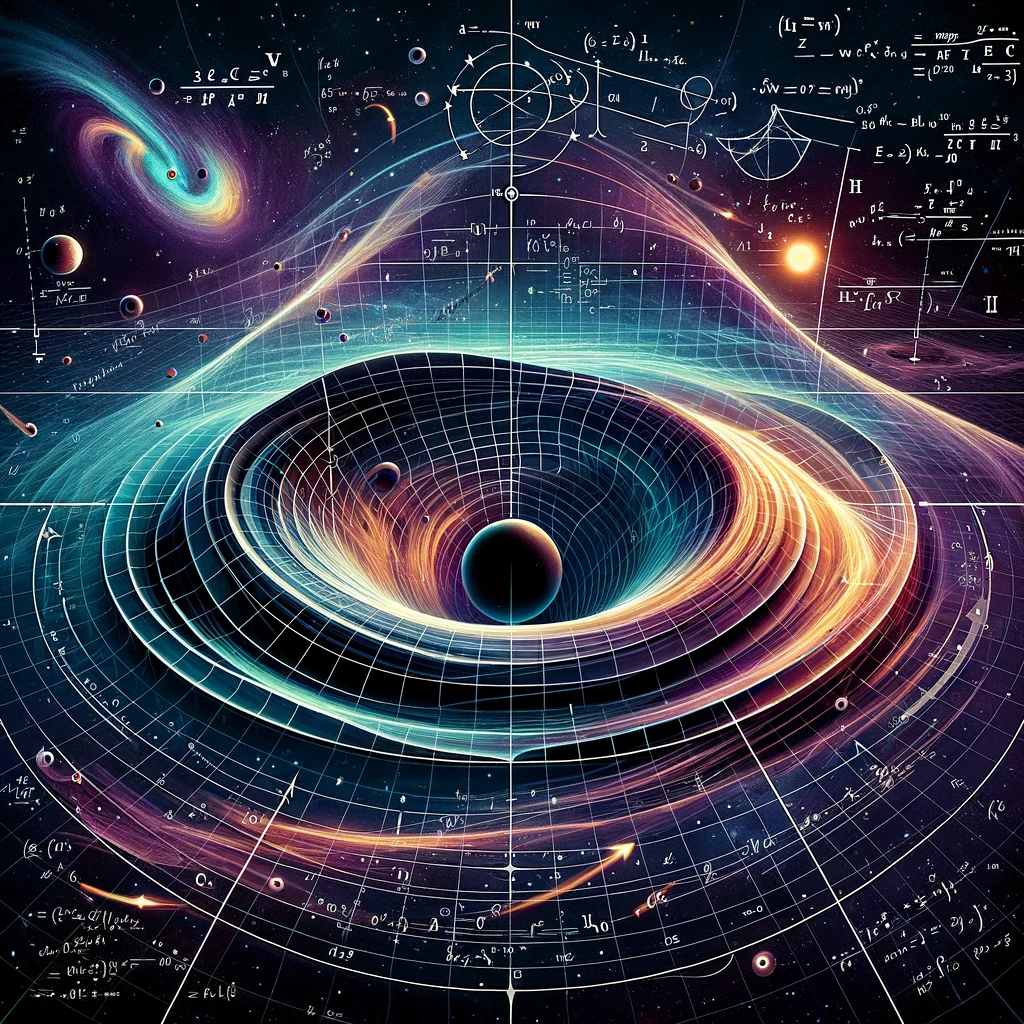
Einstein’s theory of spacetime is closely related to his theory of relativity, but they are not exactly the same thing. Let’s break down the relationship between the two:
-
Theory of Relativity: Albert Einstein developed two major theories of relativity: special relativity and general relativity. These theories revolutionized our understanding of space, time, and gravity.
-
Special Relativity: Einstein’s theory of special relativity, published in 1905, introduced the concept of spacetime, where space and time are interwoven into a four-dimensional continuum. It also introduced the famous equation E=mc2, which relates energy (E) to mass (m) and the speed of light (c). Special relativity deals with the behavior of objects moving at constant speeds in the absence of gravitational forces.
-
General Relativity: Einstein’s theory of general relativity, published in 1915, expanded upon special relativity to include the effects of gravity. General relativity describes gravity as the curvature of spacetime caused by the presence of mass and energy. According to this theory, massive objects like planets and stars warp the fabric of spacetime, influencing the motion of other objects within it.
-
-
Spacetime: The concept of spacetime is central to both special and general relativity. In special relativity, spacetime is a unified framework that combines the three dimensions of space with the dimension of time into a single, four-dimensional continuum. In general relativity, spacetime is further extended to incorporate the effects of gravity, where the curvature of spacetime is determined by the distribution of mass and energy.
In summary, while Einstein’s theory of spacetime is intimately connected to his theories of relativity, it specifically refers to the framework that combines space and time into a unified continuum. This concept is fundamental to both special and general relativity, which provide deeper insights into the nature of the universe and its fundamental laws.
Spacetime
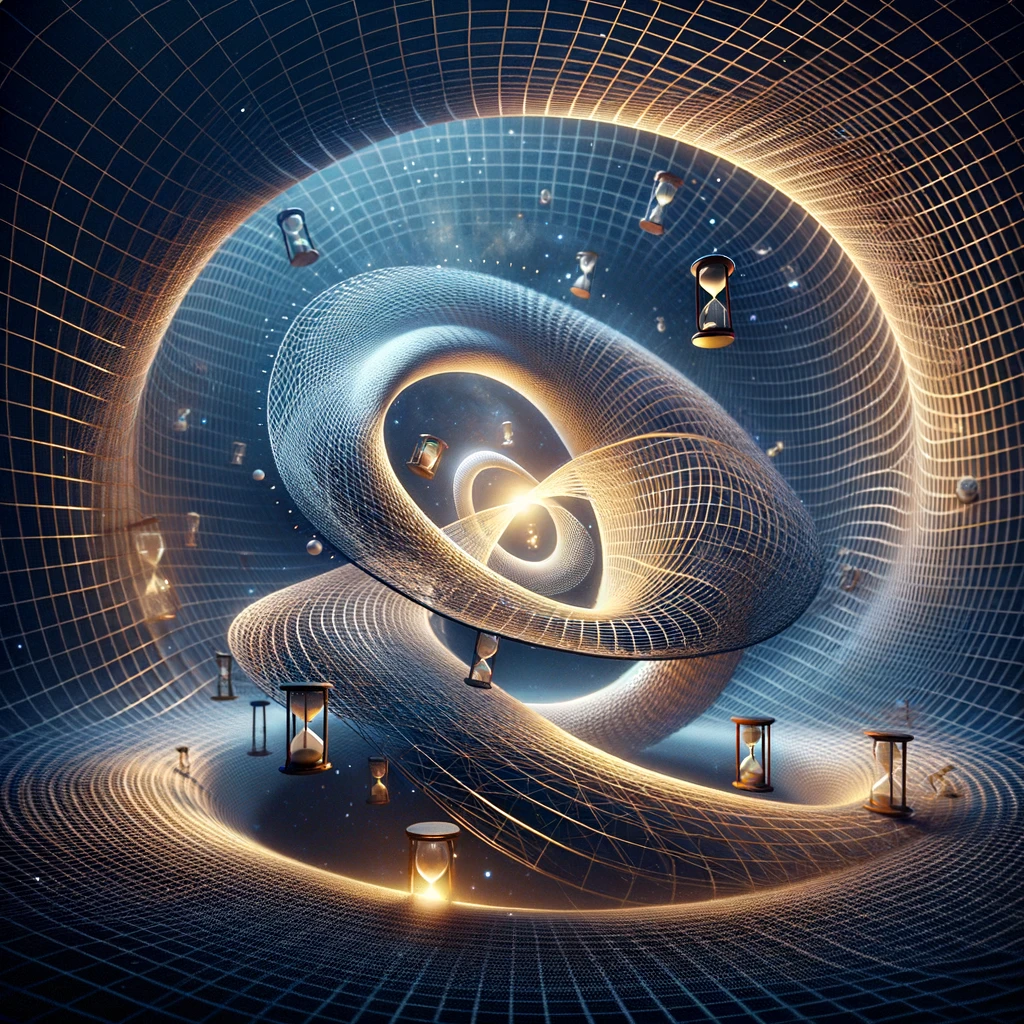
Spacetime, in the realm of physics, is a fundamental concept that combines the three dimensions of space—length, width, and height—with the dimension of time into a single, unified framework. It’s a mathematical model used to describe the physical universe in a way that accounts for both spatial and temporal dimensions. Here’s a breakdown of the concept:
Three Spatial Dimensions: In everyday experience, we perceive the world around us in three spatial dimensions: length, width, and height. These dimensions define the physical extent of objects and the distances between them in space.
The Dimension of Time: Time is often considered the fourth dimension, separate from the three spatial dimensions. It represents the progression of events and the interval between them. Unlike spatial dimensions, which describe positions and distances, time describes the sequence of events and the duration between them.
Combining Space and Time: Spacetime, as conceptualized in physics, combines the three spatial dimensions with the dimension of time into a single, four-dimensional continuum. In this framework, objects and events are described not only by their positions in space but also by their positions in time.
Einstein’s Theory of Relativity: The concept of spacetime is central to Albert Einstein’s theories of relativity—special relativity and general relativity. In special relativity, Einstein introduced the idea that space and time are interconnected, and that measurements of space and time can vary depending on the relative motion of observers. In general relativity, Einstein extended this concept by proposing that gravity is not just a force between objects, but rather a curvature of spacetime caused by the presence of mass and energy.
Curvature of Spacetime: According to general relativity, massive objects like stars and planets warp the fabric of spacetime around them, creating gravitational fields. The curvature of spacetime influences the motion of objects within it, causing them to follow curved paths dictated by the geometry of spacetime.
In summary, spacetime is a foundational concept in physics that unifies the three dimensions of space with the dimension of time into a single, four-dimensional framework. It provides a mathematical model for describing the structure of the universe and the interplay between space, time, and gravity.
ELI 5: Spacetime
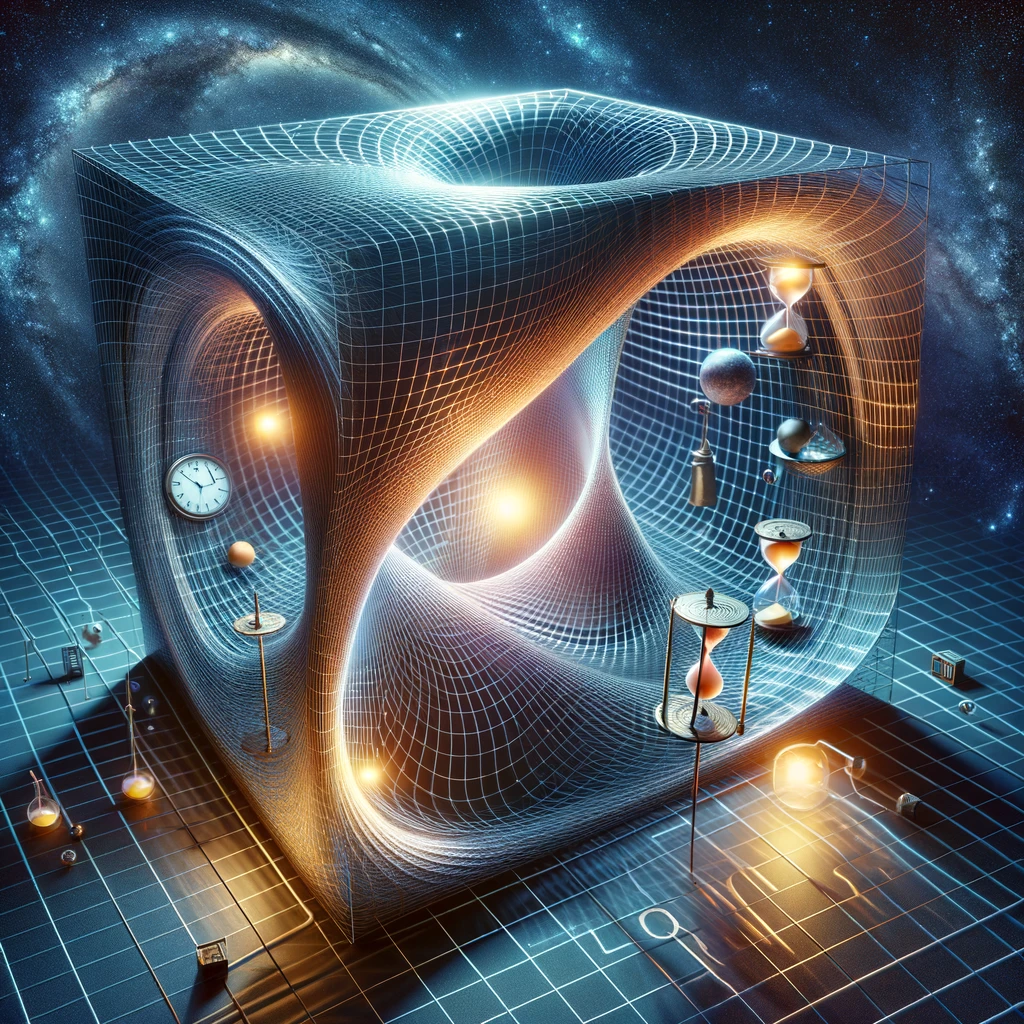
Let’s break down Einstein’s ideas in simpler terms:
Space and Time Together: Imagine you’re standing still, not moving at all. You experience time passing, right? Now, imagine you start moving, maybe walking or running. Einstein said that when you move, time doesn’t pass for you in the same way as it does for someone who’s standing still. This idea that time can change depending on how you’re moving is called time dilation.
Spacetime: Einstein combined the idea of space and time into one big concept called “spacetime.” It’s like thinking about a big blanket where space and time are woven together. Whenever something happens, like an event or motion, it happens somewhere in this spacetime fabric.
Gravity and Spacetime Curvature: You know how a heavy ball placed on a bed creates a dip in the mattress? In the same way, Einstein said that massive objects, like planets or stars, actually bend or warp the fabric of spacetime around them. This warping is what we feel as gravity. Things in space, like planets, move along the curves or paths created by this warped spacetime, just like marbles rolling along the dips in the mattress.
So, in simpler terms, Einstein’s ideas tell us that space and time aren’t separate things, but they’re woven together in a fabric called spacetime. And when things like planets or stars with mass are around, they actually warp this fabric, which is what we feel as gravity.
Time can be perceived differently depending on...
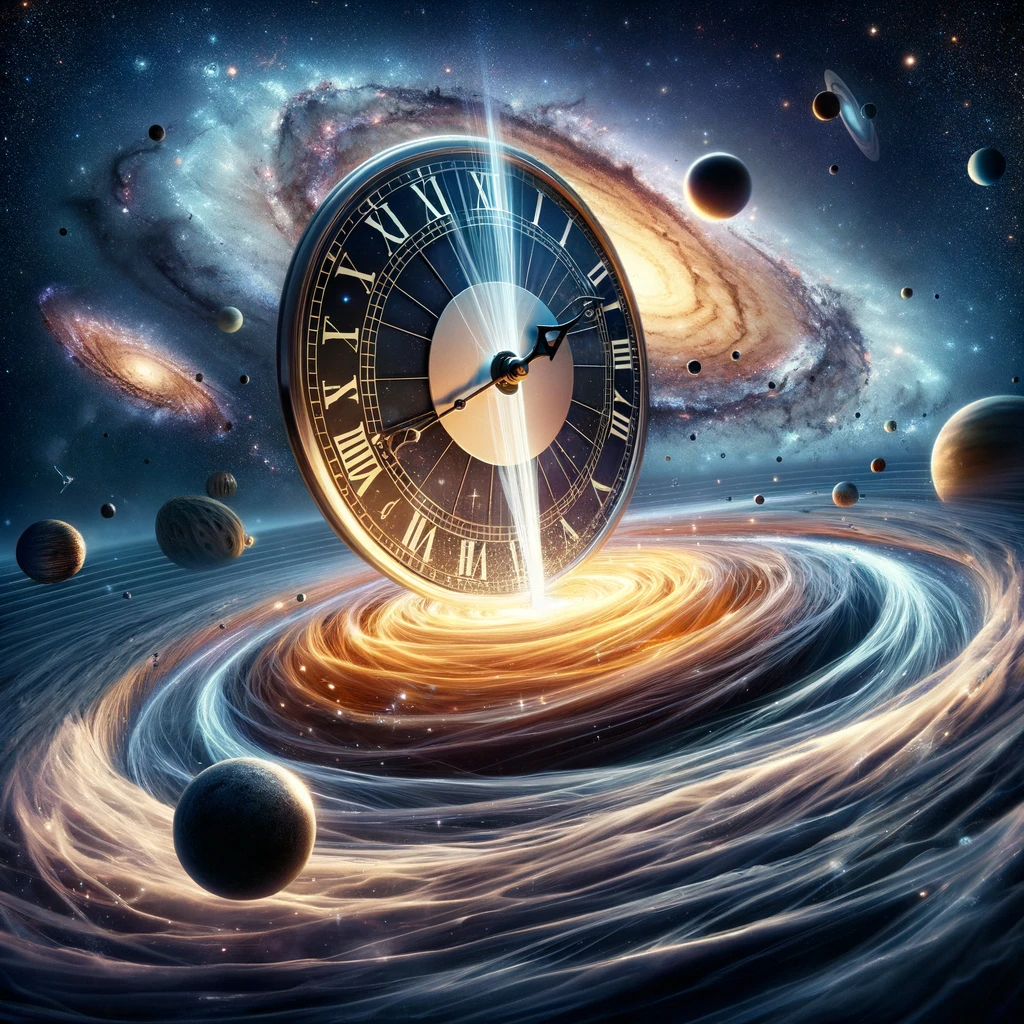
In the context of Einstein’s theory of relativity, time itself doesn’t actually speed up or slow down in an absolute sense. Instead, time dilation refers to how time is perceived or experienced by observers in different gravitational fields or relative motion.
Gravitational Time Dilation: In the presence of a strong gravitational field, such as near a massive object like a planet or star, time appears to pass more slowly for observers closer to the source of gravity compared to those farther away. This means that clocks in stronger gravitational fields run slower relative to clocks in weaker gravitational fields. However, from the perspective of an observer within the gravitational field, time proceeds at a normal rate. It’s only when comparing clocks between different gravitational fields that the time dilation effect becomes apparent.
Velocity Time Dilation: Similarly, when considering objects moving relative to each other at different velocities, time dilation occurs. Time appears to pass more slowly for objects moving at high speeds relative to stationary observers. Again, from the perspective of an observer on the moving object, time proceeds at a normal rate. The time dilation effect is only observed when comparing clocks between different reference frames.
So, while time dilation can make it seem as though time is speeding up or slowing down from the perspective of different observers or reference frames, time itself remains constant and invariant. It’s the relative motion or gravitational field that affects how time is perceived by different observers.
Spacetime vs. the Fourth Dimension

In a sense Spacetime and the Fourth Dimension are the same, but it’s important to clarify the distinction between the two concepts:
Spacetime: Spacetime is a unified framework that combines the three spatial dimensions (length, width, and height) with the dimension of time into a single, four-dimensional continuum. In this framework, objects and events are described not only by their positions in space but also by their positions in time. Spacetime is a fundamental concept in physics, particularly in Einstein’s theory of relativity, where it serves as the stage on which the dynamics of the universe unfold.
Fourth Dimension: The term “fourth dimension” is often used in a more general sense to refer to an additional spatial dimension beyond the three familiar dimensions. While spacetime does encompass four dimensions—three spatial dimensions and one dimension of time—when people talk about the “fourth dimension” outside of the context of spacetime, they may be referring to a hypothetical spatial dimension beyond our ordinary perception.
So, while spacetime incorporates the fourth dimension in the context of time, the term “fourth dimension” is sometimes used more broadly to explore speculative ideas about additional spatial dimensions beyond the three we experience in everyday life.
Evidence of Einstein's Spacetime Theory
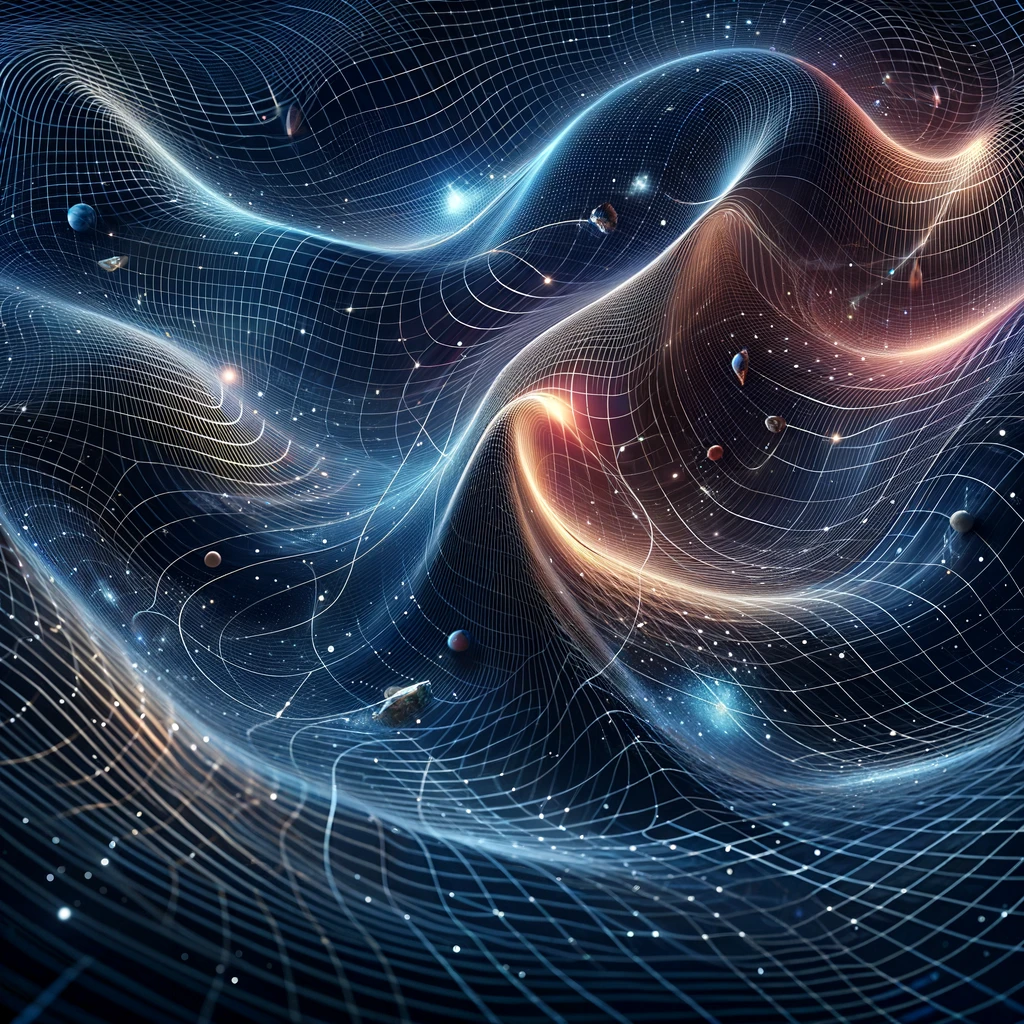
There is considerable evidence supporting Einstein’s concept of spacetime as a fabric that can be warped by massive objects like planets and stars. Some of the key pieces of evidence include:
-
Gravitational Lensing: When light from distant stars or galaxies passes close to a massive object, such as a galaxy cluster or a black hole, the gravitational field of the massive object bends the path of light. This bending of light, known as gravitational lensing, causes the distant objects to appear distorted or magnified when observed from Earth. The observed effects of gravitational lensing are consistent with the predictions of general relativity, providing strong evidence for the curvature of spacetime by massive objects.
-
Gravitational Waves: In 2015, scientists made a groundbreaking discovery by directly detecting gravitational waves for the first time. Gravitational waves are ripples in the fabric of spacetime produced by violent events in the universe, such as the collision of black holes or the merging of neutron stars. The detection of gravitational waves confirmed a key prediction of general relativity and provided direct evidence for the dynamic nature of spacetime.
-
Tests of General Relativity: Numerous experiments and observations have been conducted to test the predictions of general relativity in various astrophysical and laboratory settings. These tests include measuring the precession of Mercury’s orbit, observing the deflection of starlight by the Sun during a solar eclipse, and analyzing the motion of objects in strong gravitational fields, such as pulsars orbiting around black holes. In each case, the results have been consistent with the predictions of general relativity, providing further validation of Einstein’s theory.
-
Cosmic Microwave Background Radiation: The cosmic microwave background (CMB) radiation is the faint glow of radiation left over from the early universe. Detailed measurements of the CMB by satellites such as the Planck mission have provided valuable insights into the large-scale structure and dynamics of the universe. The patterns observed in the CMB are consistent with the predictions of general relativity and support the idea of an expanding universe governed by the curvature of spacetime.
These and other lines of evidence strongly support the concept of spacetime as a dynamic fabric that can be curved or warped by the presence of mass and energy, as described by Einstein’s theory of general relativity.
Touching on Blackholes
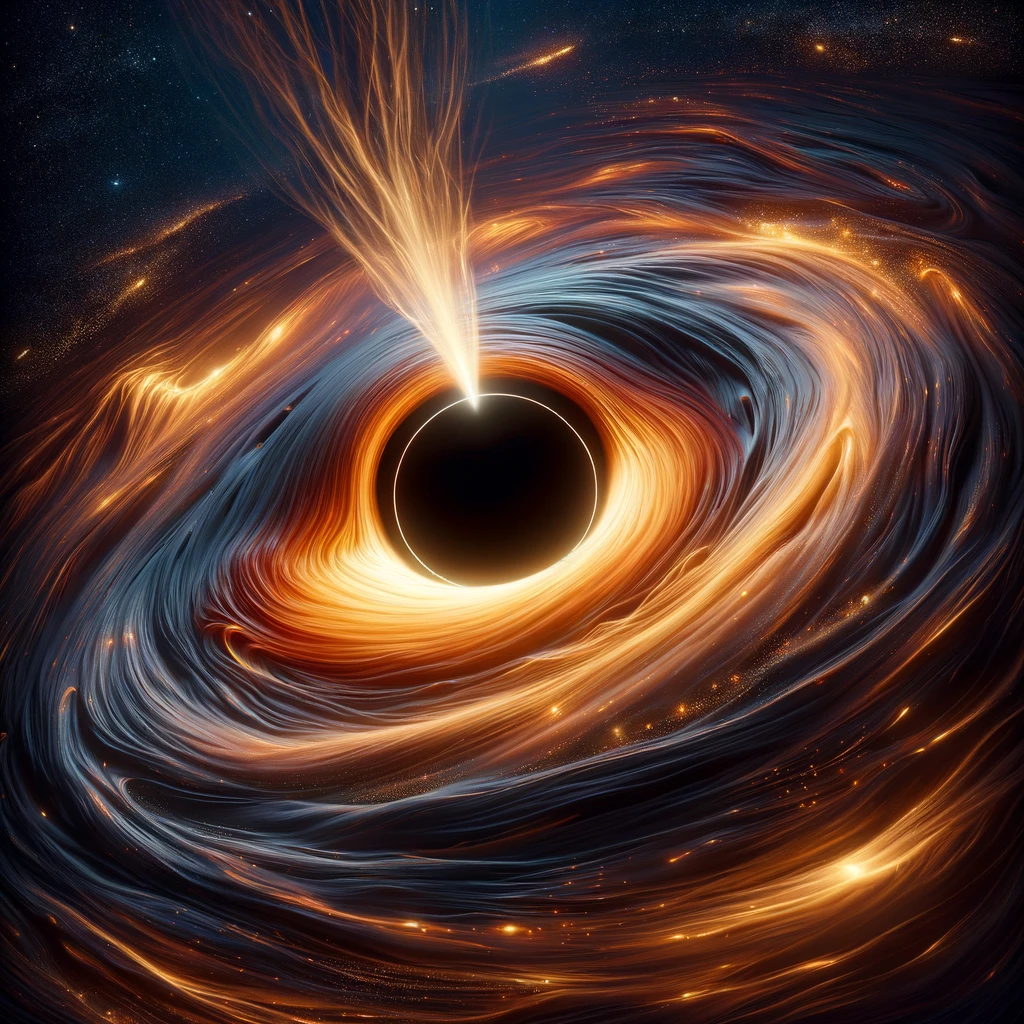
Black holes are fascinating objects predicted by the theory of general relativity and play a significant role in spacetime. Let’s explore the relationship between black holes and spacetime:
Curvature of Spacetime: According to Einstein’s theory of general relativity, massive objects like stars and planets warp the fabric of spacetime around them. Black holes are the most extreme manifestation of this curvature, where the gravitational pull is so strong that not even light can escape from within a region known as the event horizon.
Singularity: At the center of a black hole lies a point of infinite density called a singularity. This is where the laws of physics, as we currently understand them, break down. The singularity represents a point of infinite curvature in spacetime, where the gravitational field becomes infinitely strong.
Event Horizon: The event horizon of a black hole is the boundary beyond which nothing, not even light, can escape. Once an object crosses the event horizon, it is inexorably pulled toward the singularity at the center of the black hole, and no information can be transmitted back out to the rest of the universe.
Time Dilation: Near the event horizon of a black hole, the gravitational field is so intense that time itself is severely warped. This phenomenon, known as gravitational time dilation, causes time to pass more slowly for an observer close to the event horizon compared to an observer far away. However, this does not allow for time travel in the sense of going back to the past.
No Time Loops: Despite the extreme curvature of spacetime near black holes, there is no evidence to suggest that black holes provide a gateway to the past or enable time loops or closed timelike curves. The concept of time travel through black holes remains speculative and is not supported by current scientific understanding.
In summary, black holes profoundly influence the curvature of spacetime and can cause extreme gravitational effects such as time dilation. The nature of black holes and their role in spacetime remains an active area of research and speculation in theoretical physics.
